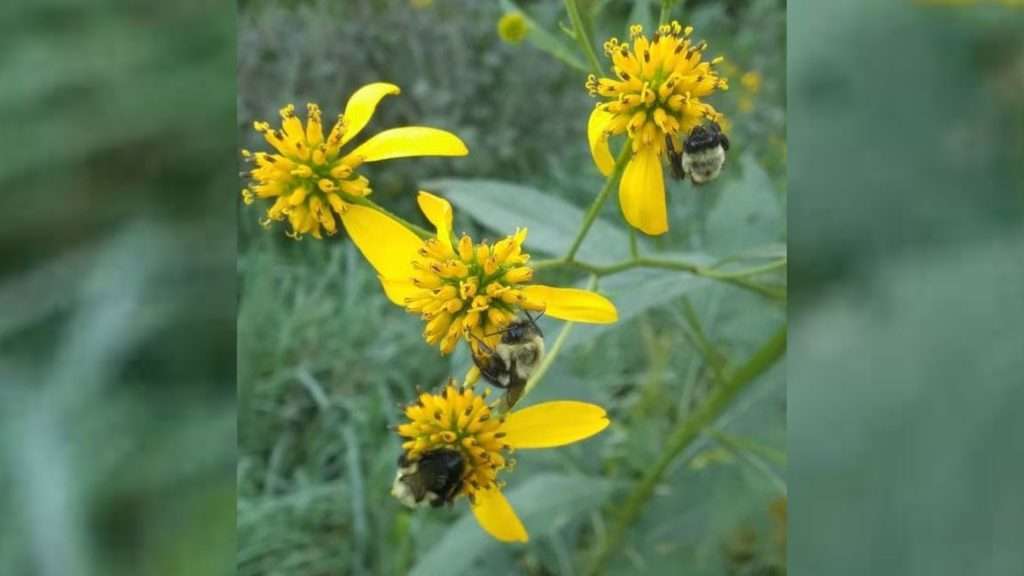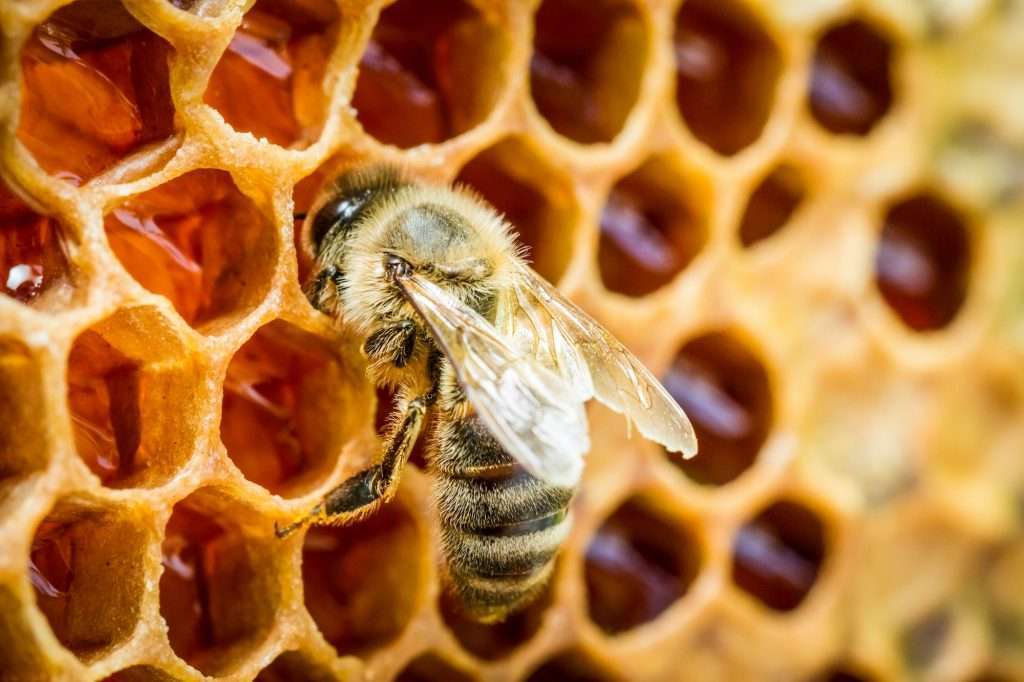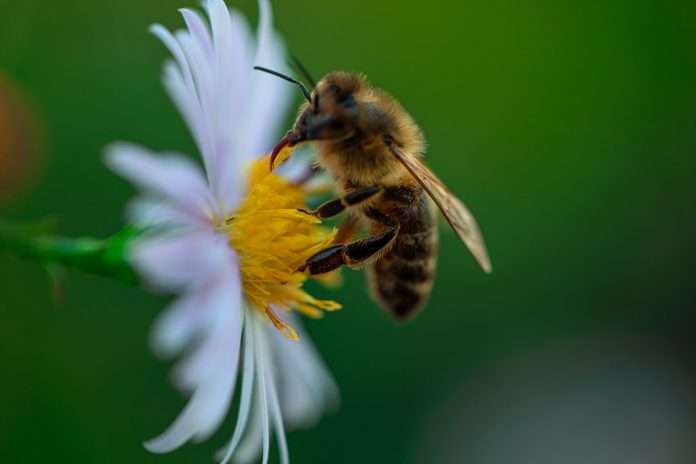Honey bees are beneficial insects to mankind and are crucial for sustaining local biodiversity. Honeybees can be found all over the world. They are usually found in areas that have an abundant supply of flowering plants, but can also survive in grasslands, deserts, and wetlands if there is sufficient water, food, and shelter. There are over 20,000 bee species in the world. Out of these, 200 are social (live in hives) and 12 are honey bees. Honeybees are extremely important for our environment. Without them, many flowers would have trouble reproducing, as bees help with pollination and transferring the pollen from one flower to another. The bees also produce honey, beeswax and royal jelly, all of which are either eaten by humans or used in cosmetics and medicine. All this is important in terms of conservation of bees and addressing pollination as an ecosystem service.
It is thought that the widespread commercialization of beekeeping is endangering local populations. While honeybees are not considered an endangered species, there are honeybee conservation organizations out there. Moving beyond the “productivist agenda” to concentrate on the bees’ most important function – maintaining ecological balance and helping agriculture through cross-pollination – is how we can bring the conversation back to our local foragers. Honey bees store honey in their honeycombs, and it is collected from wild bee colonies, or from hives of domesticated bees, a practice is known as beekeeping or apiculture. Honey is sweet because of the monosaccharides fructose and glucose. Honey is a complex substance made when bees ingest nectar, process it, and store the substance in honeycombs. All living species of Apis have had their honey gathered by indigenous peoples for consumption. Apis mellifera and Apis cerana are the only species that have had their honey harvested for commercial purposes.
Also read:
- Mushrooms – Conservation and Sustainable Management
- Withering Watersheds – Issues, Challenges, Impacts, And Possible Solutions In An Era of Climate Change
- Climate-proofing of Watersheds – A Few Soil and Water Conservation Models Across India

Population numbers also declined more than usual in the winters of the early 2000 and that contributed to the idea that the honeybees were disappearing. More than a third of the commercial honeybees died during the winter of 2009-10, showed the annual survey data released by the US Agricultural Research Service. This is a continuous drop in the past three years. Several European and Asian countries have also reported losses at the American scale for the past three years. Beekeepers are worried because bee colonies naturally lose 5 percent of their population annually, but since 2006 they have been losing 30 to 90 percent of their population a year. It said the catastrophic fall in bee numbers is not due to any single factor. Parasitic, bacterial, and viral infections, exposure to pesticides and radiation from mobiles, poor nutrition, and global warming are all concomitant factors that threaten the survival of honeybee colonies worldwide. Since knowledge on bee diseases is insufficient, OIE has called on the international community to intensify research on how to fight emerging and known diseases.
The truth is that although humans have destroyed half of the planet, the bee numbers are just fine. This does not mean we shouldn’t be aware of our influence over them. Just because they are not endangered, it does not mean they are safe. There are a number of problems that honey bee populations have to face. These days we see a massive decrease in bee population due to various reasons such as cutting of flowering trees on large scale in cities, diminishing forest belts, destroying bee hives (bee nests) out of ignorance and fear by using fire or pest control, destroying bee hives while extracting the honey by using unscientific methods, building tall mobile phone towers that emit powerful electromagnetic waves, using hazardous chemical insecticides, pesticides, weedicides in farms, drastic climate changes, etc. We all have heard over and over again that bees are dying out. This has led to a global panic, because if the bees die out, so do we. We are reliant on bees for most of our food, so if they become instinct, there will be serious repercussions in the entire food chain. It is also true that various species of bees have made it to the endangered lists. Honey bees, though, are not included in this group just yet. There was a frenzy when honey bee numbers appeared to drop dramatically, but that was mostly due to mismanagement by beekeepers.
Climate change is harming the bees. It may not be wiping the bees out directly, but it is destroying the crops that they feed on. Bees are at risk of starvation now, because soon there won’t be enough food for all of them to live off. Changing weather also negatively impacts them. Honeybees are not built to withstand extremes. Droughts, fires, unusually heavy snow, rains, and extreme heat and cold could damage their nests too. Such weather conditions also ruin crops, adding to the hunger problem for the honey bees. Insufficient food could contribute to colony collapse disorder. If a colony cannot function (for various reasons: disease, pollution, starvation, uninhabitable conditions, etc.), the worker bees abandon it. The bees left behind often cannot take care of themselves, and this leads to what appears to be rapid death rates in the bee population.
Bees are needed, not just for honey…but to produce our daily foods

A world without bees would be much a world without food – literally. The fact is bees are important, not just for the honey they give us, but for their “services” as pollinators. As they move from plant to plant, sucking the nectar of flowers, they also spread pollen. Fertility in the ecosystem is dependent on bees. In addition to increasing crop yield through cross pollination, honeybees also increase the biodiversity through pollination and perpetuation of a whole lot of plants in this world, wild or cultivated, in farm fields or forests.
It is estimated a third of the food we eat solely depends on honeybees for pollination; the insect contributes about US $38 billion to the global economy. Bees contribute to global food security and their extinction would represent a terrible biological disaster. The Food and Agriculture Organization (FAO), estimates that pollinators affect 35 per cent of the world’s crop production, increasing outputs of 87 of the leading food crops worldwide, plus many plant-derived medicines. Honey bees are often described as essential to human food production, leading to claims that without their pollination humanity would starve or die out. However, many important food crops need no insect pollination at all. The ten most important food crops, comprising 60% of all human food energy, fall into this category: plantains are sterile and propagated by cuttings, as are cassava; potatoes, yams, and sweet potatoes are root vegetables propagated by tubers; soybeans are self-pollinated; and rice, wheat, sorghum, and maize are wind-pollinated, as are most other grasses. No crops originating in the New World depend on the western honey bee (Apis mellifera) at all, as the bee is an invasive species brought over with colonists in the last few centuries. Tomatoes, peppers, squash, and all other New World crops evolved with native pollinators such as squash bees, bumble bees, and other native bees.
Indigenous bees have evolved in India, they know the plants, the terrain, and are better able to adapt to the changes in the environment. In the last couple of years, many Mellifera colonies have absconded (reacting to the heat and rains). But native bees don’t do this as much. The ‘buzz’ is loud, as all four of India’s indigenous honey bees – the Apis cerana indica, Apis dorsata, Apis florea and Trigona (stingless bee) – get to work collecting nectar and pollen. In this way, the livelihood of the beekeeper is intertwined with the food we eat. If the beekeeper goes out of business because honey is adulterated, then food will be under threat. Without the bee, we lose much more than the goodness of honey; we lose the productivity of our ecosystem itself. We lose life.
What makes honey different?

Honey is sugar, but it is special. One tablespoon of honey (21 grams) contains slightly higher calories than sugar. It mainly comprises sugar carbohydrates, which are glucose and fructose. But the “sugar” of honey is transformed to goodness because of the way the bees collect it from the sweet nectar of plants and how they “manufacture” it in the beehives. Bees consume, digest and regurgitate the nectar and it is this that makes it so beneficial for us. Honey is then not about the “sugar”, but the enzymes, amino acids, phenolic compounds like flavonoids, minerals and other phyto-chemicals. It is these that give honey antioxidant, antimicrobial, anti-inflammatory properties. Honey is scientifically proven to be good for our immune system and improves our well-being. This is why starting your day with honey in warm water is well advised. It provides us the ability to manage the oxidative stress that results from lifestyle, dietary and environmental strain. This oxidative stress is the reason for cellular degeneration that results in several chronic ailments such as metabolic and cardiovascular diseases as well as aging. In addition, honey is also known for gut health.
A Sugar-coated hoax
Now, imagine starting your day with a shot of sugar syrup! Even if the honey you are consuming is adulterated with 50 percent sugar syrup, it means you are getting empty calories without any benefits. It will do you harm. Not good. Now let’s consider this during COVID-19. It is sheer poison. We are not getting what will protect us from the virus, by improving our overall health and immunity. But worse, we are consuming honey with sugar syrup, which puts us in the danger of adding weight and will make us more vulnerable to the virus attack. In the US, the Centers for Disease Control and Prevention (CDC) has said that people with even moderately excess weight may have increased risks of severe COVID-19 infection. This has expanded the risk to larger numbers of people, who may not be declared “obese” but are “over-weight” – weight that is greater than what is considered healthy for certain height. In the initial months of the COVID-19 pandemic, it was not clear why weight was linked to the risk of the disease and its virulence. But as months have gone by, this connection is now clear. One link is with the adipose tissue – the fat in our bodies – that is now understood to be biologically active and promotes low-intensity chronic inflammation in the body, even without infection. This makes our body more immune suppressed and more vulnerable to coronavirus diseases. Then there is the problem of abdominal obesity, which adds stress to the lungs.
Studies are suggesting that the epidemic of obesity and COVID-19 can be viewed as a syndemic, as they negatively interact with one another to exacerbate the course of diseases, leading to greater complications and severe illness. Together they create a simultaneous and significant burden on the health system. In this way, consuming honey laced with sugar will make us all more likely to fall into the obesity trap — and this is when Indians already have a huge burden of obesity on their hands. We also know that obesity is the primary trigger for hypertension, type-2 diabetes and many chronic ailments. India is on the path of becoming an obesity capital of the world – overweight and obesity levels among 15-49-year-old populations have doubled in a decade. In urban areas, about one-third of the population is overweight and or obese. This makes it all the more deadly. We are consuming honey – more of it during in these days to fight the COVID-19 infection. But the honey adulterated with sugar will not make us well. It will make us even more vulnerable to COVID-19. It is double jeopardy.
India is at high risk
Agricultural economies like India are at high risk of bee decline. Of the 160 million hectares (ha) cropped area in India, some 55 million ha depends on honeybees for pollination. Without them India’s food production will reduce by one-third, he cautioned. Several bee research projects are underway with funding from the All India Coordinated Project on Honey Bees and Pollinators and by institutions like Punjab University in Punjab. The researches show the bee population in India is declining, but there is no information on the extent. The institutions do not coordinate and most focus on beekeeping, honey and wax production. There is an urgent need to initiate research on these aspects to develop strategies to sustain crop productivity.
How to woo the bee?

Our civilization is also capable of bringing bee populations to their knees. Urbanization and deforestation have a strong hand in the destruction of bee habitats (and again, their food sources). People are also far too hasty in destroying encroaching beehives instead of getting them professionally and humanely removed. Honeybees have a secret weapon though-beekeepers. While other bees and (other pollinators) are at risk of endangerment and extinction, honeybees are, by default, protected by us. The hives we build, and the conditions we provide for them (mostly to harvest their honey) have kept them safe in a world that is otherwise not very kind to them.
Honeybees, as common and stereotyped as they may be, are in reality the underdogs of the bee world. Their defining traits (their one-time stings, their intricate nests, and their honey) are unusual on the larger scale. It’s what singles them out, but it’s also what protects them. These little guys (and girls) are an invaluable and wonderful part of our ecosystem. It does no harm to learn more about them so that the next time you see one you’ll be fascinated, rather than afraid. Be kind to them. We need them just as much as they need us.
Scientists suggest shifting to organic farming could save the bees. It benefits to biodiversity from organic farming are much lower than believed; it is 12 percent more than conventional farming. Organic farms also yield less than half of conventional farms. The decline in monoculture as it restricts bee’s food resources. Scientists also suggest limiting habitat destruction and we are in an ironic situation. With the growing population, the world needs more food and thus more pollinators and farmland. While expanding farmland, man is destroying natural habitat as well as the pollinators.”
The conservation of these honey bee populations (feral and managed colonies) is a pressing priority, given that their survival in natural habitats is endangered by the same factors that affect wild pollinators. Natural areas, specially protected areas, are critical for the conservation of the wild populations of the western honey bee in its native range.
Misconceptions about bees
- Honey bees come in various sizes shapes and colors and depend on many different species for their survival.
- All honey bees do not build a hive and store nectar. Some stay solitary and also build small nests for their offerings like the leaf cutter honey bee.
- Honey bees are not free from predators. They are often targets of other predators like hornets who can destroy colonies.
- Honey bees do not store Honey for humans. They use it to rear the young. A single live honey bee provides more service as a pollinator than a Honey maker when it comes to human benefits.
- Honey bees are not immune to the effect of chemicals and insecticides in flowers and nectar can affect their development as well as the quality of honey.
- All honey bees may not be desirable in an area especially if they are an alien species with an ability to disrupt the existence of local native honey bees such as the Asian honey bee in the United States.
- Honey bees may not always be seen flying but that does not mean they are absent in an ecosystem. Honey bees can also hibernate during extreme weathers and thus litter and fallen leaves should not be tampered with as these serve as a refuge for the bees.


